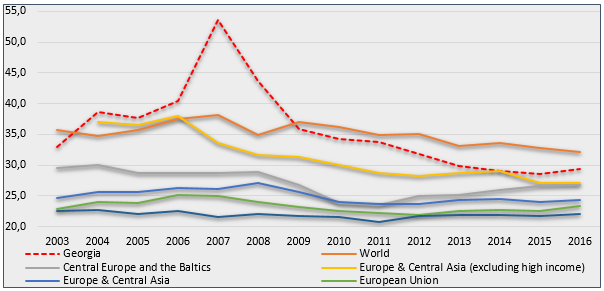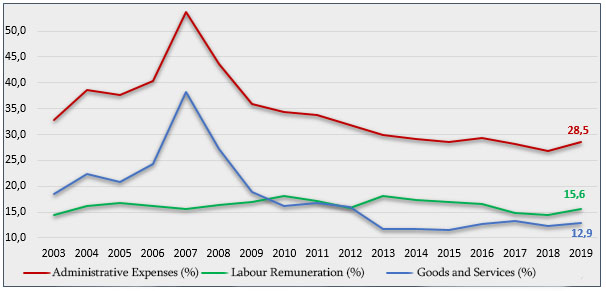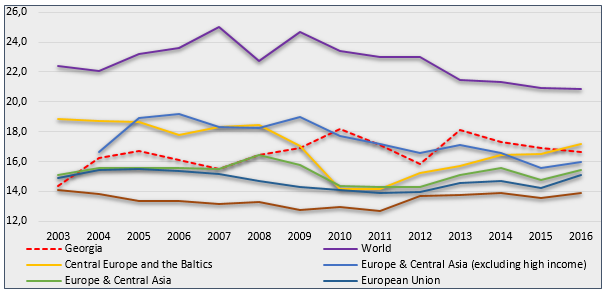Verdict: FactCheck leaves Roman Gotsiridze’s statement WITHOUT A VERDICT.
Resume: In accordance with the data for 2016, the share of administrative (bureaucratic) expenses in the Georgian budget’s current expenditures constitutes 29.4%. Of these expenses, labour remuneration constitutes 16.6% and the purchase of goods and services constitutes 12.8%. Globally, the average share of administrative expenses in 2018 constitutes 32.1% whilst this figure sits at 27% in Europe and Central Asia (excluding high-income countries). In the last years, the share of administrative expenses in the Georgian budget’s current expenditures has been decreasing and dropped to 26.8% in 2018 whilst administrative expenses are estimated to reach 28.5% within the current expenditures of the 2019 state budget. As of 2016, the administrative expenses to current expenditures ratio is lower in Georgia as compared to 70 other nations of the world.
Seemingly, Georgia’s budget’s administrative expenses are lower in the last years as compared to the world average and do not substantially exceed the average figures[1] for the group of countries which is relevant for comparison. Against the backdrop of the decreasing share of bureaucratic expenses in the state budget, it is likely that Georgia’s 2019 budget will not be one of the most bureaucratic budgets in the world when the share of bureaucratic expenses in the 2019 state budget is still lower than the figure for 2016 (despite being increased as compared to 2018). Similar figures for other countries are not currently available and so a comparison cannot be made. Therefore, FactCheck leaves Roman Gotsiridze’s statement without a verdict.
Analysis
The Chair of the United National Movement Parliamentary Faction, Roman Gotsiridze, during a discussion of the 2019 draft state budget in the Parliament of Georgia stated that bureaucratic expenses create a major problem for the 2019 draft state budget. As stated by Mr Gotsiridze, “this is one of the most bureaucratic budgets (the 2019 budget project) in the world.”
A budget’s administrative (bureaucratic) expenses are part of the current expenditures. In turn, administrative expenses are the sum of budget funds allocated for labour remuneration and the purchase of goods and services. The functions of a state are unequal in different countries and vary between different levels (central, local) of government. The primary of functions of a government in terms of spending are related to a budget’s current expenditures whilst administrative expenses are those designated for the administrative and human resources required to carry out those functions. Therefore, in order to verify Roman Gotsiridze’s statement, we need to analyse the administrative expenses of the state budget in relation to current expenditures.
Currently, the International Monetary Fund and World Bank databases possess statistical figures for public finances for all countries as of 2016. Therefore, it is possible to compare Georgia’s state budget’s administrative expenses to similar figures for other countries through to 2016.
Graph 1: Budget Administrative Expenses to Current Expenditures Ratio[2] (%)
 Source: World Bank, International Monetary Fund
In 2016, the administrative expenses to current expenditures ratio in the state budget was 29.4% which is 2.7 percentage points less as compared to the world average of the same year and exceeds the average figure for Europe and Central Asia (excluding high-income countries) by 2.4 percentage points. The administrative expenses to current expenditures ratio is 23.3% on average in the EU whilst the average figure for OECD[3] member nations is 22.1%. This figure peaked during the 2007-2008 global financial crisis. In the same years, Georgia’s administrative expenses to current expenditures ratio (43.6% and 35.9%, respectively) was much higher as compared to the following years.
Since 2013, the administrative expenses to current expenditures ratio in Georgia’s budgets has been declining annually. In 2013-2018, the average annual drop constitutes 0.8 of a percentage point. However, the administrative expenses to current expenditures ratio in the 2019 draft state budget is poised to be increased by 1.7 percentage points as compared to 2018. In the 2019 draft state budget, the administrative expenses to current expenditures ratio is 28.5%. Of this amount, 15.6% is allocated for labour remuneration and 12.9% for purchasing goods and services. In addition, the administrative expenses to current expenditures ratio as envisioned in the 2019 draft state budget is 0.9 of a percentage point lower as compared to the same figure for 2016.
Graph 2: Administrative Expenses to Current Expenditures Ratio in the State Budget (%)
Source: World Bank, International Monetary Fund
In 2016, the administrative expenses to current expenditures ratio in the state budget was 29.4% which is 2.7 percentage points less as compared to the world average of the same year and exceeds the average figure for Europe and Central Asia (excluding high-income countries) by 2.4 percentage points. The administrative expenses to current expenditures ratio is 23.3% on average in the EU whilst the average figure for OECD[3] member nations is 22.1%. This figure peaked during the 2007-2008 global financial crisis. In the same years, Georgia’s administrative expenses to current expenditures ratio (43.6% and 35.9%, respectively) was much higher as compared to the following years.
Since 2013, the administrative expenses to current expenditures ratio in Georgia’s budgets has been declining annually. In 2013-2018, the average annual drop constitutes 0.8 of a percentage point. However, the administrative expenses to current expenditures ratio in the 2019 draft state budget is poised to be increased by 1.7 percentage points as compared to 2018. In the 2019 draft state budget, the administrative expenses to current expenditures ratio is 28.5%. Of this amount, 15.6% is allocated for labour remuneration and 12.9% for purchasing goods and services. In addition, the administrative expenses to current expenditures ratio as envisioned in the 2019 draft state budget is 0.9 of a percentage point lower as compared to the same figure for 2016.
Graph 2: Administrative Expenses to Current Expenditures Ratio in the State Budget (%)
 Source: Ministry of Finance of Georgia
In regard to labour remuneration which is one of the most important components of bureaucratic expenses, the world average labour remuneration to current expenditures ratio is 20.9% as of 2016 which exceeds Georgia’s average by 4.3 percentage points. The average figure for Europe and Central Asia (excluding high-income countries) is 16% which is 0.6 of a percentage point lower than Georgia’s average. The labour remuneration to current expenditures average ratio is 15.1% in the EU whilst the average figure for the OECD is 13.9%.
Graph 3: Labour Remuneration to Current Expenditures Ratio (%)
Source: Ministry of Finance of Georgia
In regard to labour remuneration which is one of the most important components of bureaucratic expenses, the world average labour remuneration to current expenditures ratio is 20.9% as of 2016 which exceeds Georgia’s average by 4.3 percentage points. The average figure for Europe and Central Asia (excluding high-income countries) is 16% which is 0.6 of a percentage point lower than Georgia’s average. The labour remuneration to current expenditures average ratio is 15.1% in the EU whilst the average figure for the OECD is 13.9%.
Graph 3: Labour Remuneration to Current Expenditures Ratio (%)
 Source: World Bank, International Monetary Fund
[1] Proximity to the group’s average means that certain countries from that group have higher bureaucratic expenses in their budget as compared to Georgia.
[2] Some countries use the GFS2001 methodology for the consolidation of public finances and others use the GFSM 2014. However, the figures shown in the graph exclude the differences based on any divergence between the methodologies.
[3] Organisation for Economic Co-Operation and Development.
Source: World Bank, International Monetary Fund
[1] Proximity to the group’s average means that certain countries from that group have higher bureaucratic expenses in their budget as compared to Georgia.
[2] Some countries use the GFS2001 methodology for the consolidation of public finances and others use the GFSM 2014. However, the figures shown in the graph exclude the differences based on any divergence between the methodologies.
[3] Organisation for Economic Co-Operation and Development.
 Source: World Bank, International Monetary Fund
In 2016, the administrative expenses to current expenditures ratio in the state budget was 29.4% which is 2.7 percentage points less as compared to the world average of the same year and exceeds the average figure for Europe and Central Asia (excluding high-income countries) by 2.4 percentage points. The administrative expenses to current expenditures ratio is 23.3% on average in the EU whilst the average figure for OECD[3] member nations is 22.1%. This figure peaked during the 2007-2008 global financial crisis. In the same years, Georgia’s administrative expenses to current expenditures ratio (43.6% and 35.9%, respectively) was much higher as compared to the following years.
Since 2013, the administrative expenses to current expenditures ratio in Georgia’s budgets has been declining annually. In 2013-2018, the average annual drop constitutes 0.8 of a percentage point. However, the administrative expenses to current expenditures ratio in the 2019 draft state budget is poised to be increased by 1.7 percentage points as compared to 2018. In the 2019 draft state budget, the administrative expenses to current expenditures ratio is 28.5%. Of this amount, 15.6% is allocated for labour remuneration and 12.9% for purchasing goods and services. In addition, the administrative expenses to current expenditures ratio as envisioned in the 2019 draft state budget is 0.9 of a percentage point lower as compared to the same figure for 2016.
Graph 2: Administrative Expenses to Current Expenditures Ratio in the State Budget (%)
Source: World Bank, International Monetary Fund
In 2016, the administrative expenses to current expenditures ratio in the state budget was 29.4% which is 2.7 percentage points less as compared to the world average of the same year and exceeds the average figure for Europe and Central Asia (excluding high-income countries) by 2.4 percentage points. The administrative expenses to current expenditures ratio is 23.3% on average in the EU whilst the average figure for OECD[3] member nations is 22.1%. This figure peaked during the 2007-2008 global financial crisis. In the same years, Georgia’s administrative expenses to current expenditures ratio (43.6% and 35.9%, respectively) was much higher as compared to the following years.
Since 2013, the administrative expenses to current expenditures ratio in Georgia’s budgets has been declining annually. In 2013-2018, the average annual drop constitutes 0.8 of a percentage point. However, the administrative expenses to current expenditures ratio in the 2019 draft state budget is poised to be increased by 1.7 percentage points as compared to 2018. In the 2019 draft state budget, the administrative expenses to current expenditures ratio is 28.5%. Of this amount, 15.6% is allocated for labour remuneration and 12.9% for purchasing goods and services. In addition, the administrative expenses to current expenditures ratio as envisioned in the 2019 draft state budget is 0.9 of a percentage point lower as compared to the same figure for 2016.
Graph 2: Administrative Expenses to Current Expenditures Ratio in the State Budget (%)
 Source: Ministry of Finance of Georgia
In regard to labour remuneration which is one of the most important components of bureaucratic expenses, the world average labour remuneration to current expenditures ratio is 20.9% as of 2016 which exceeds Georgia’s average by 4.3 percentage points. The average figure for Europe and Central Asia (excluding high-income countries) is 16% which is 0.6 of a percentage point lower than Georgia’s average. The labour remuneration to current expenditures average ratio is 15.1% in the EU whilst the average figure for the OECD is 13.9%.
Graph 3: Labour Remuneration to Current Expenditures Ratio (%)
Source: Ministry of Finance of Georgia
In regard to labour remuneration which is one of the most important components of bureaucratic expenses, the world average labour remuneration to current expenditures ratio is 20.9% as of 2016 which exceeds Georgia’s average by 4.3 percentage points. The average figure for Europe and Central Asia (excluding high-income countries) is 16% which is 0.6 of a percentage point lower than Georgia’s average. The labour remuneration to current expenditures average ratio is 15.1% in the EU whilst the average figure for the OECD is 13.9%.
Graph 3: Labour Remuneration to Current Expenditures Ratio (%)
 Source: World Bank, International Monetary Fund
[1] Proximity to the group’s average means that certain countries from that group have higher bureaucratic expenses in their budget as compared to Georgia.
[2] Some countries use the GFS2001 methodology for the consolidation of public finances and others use the GFSM 2014. However, the figures shown in the graph exclude the differences based on any divergence between the methodologies.
[3] Organisation for Economic Co-Operation and Development.
Source: World Bank, International Monetary Fund
[1] Proximity to the group’s average means that certain countries from that group have higher bureaucratic expenses in their budget as compared to Georgia.
[2] Some countries use the GFS2001 methodology for the consolidation of public finances and others use the GFSM 2014. However, the figures shown in the graph exclude the differences based on any divergence between the methodologies.
[3] Organisation for Economic Co-Operation and Development.
Tags:








